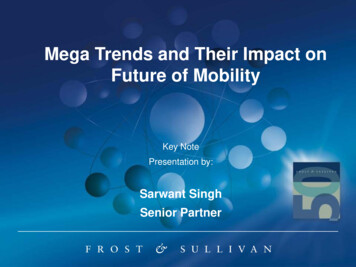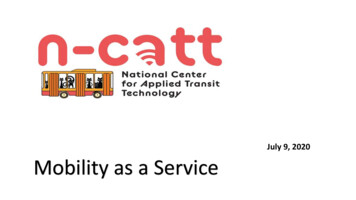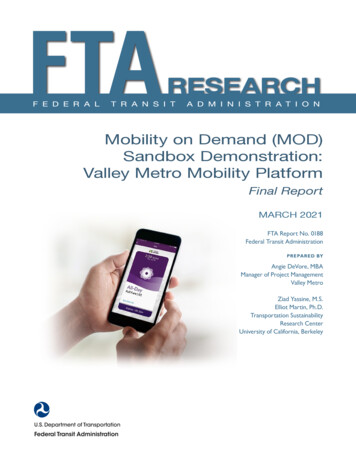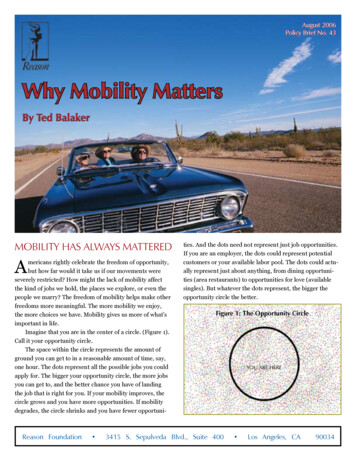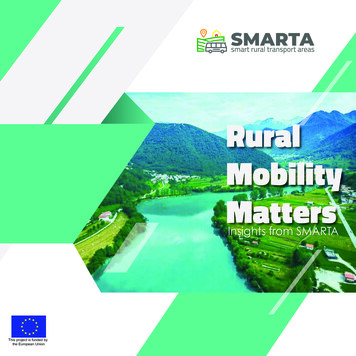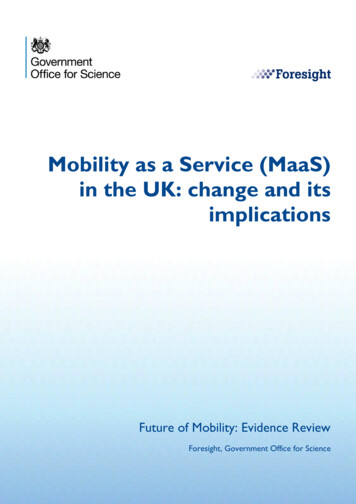
Transcription
Mobility as a Service (MaaS)in the UK: change and itsimplicationsFuture of Mobility: Evidence ReviewForesight, Government Office for Science
Mobility as a Service (MaaS) in theUK: change and its implicationsProfessor Marcus EnochSchool of Architecture, Building and Civil Engineering, LoughboroughUniversityDecember 2018This review has been commissioned as part of the UKgovernment’s Foresight Future of Mobility project. The viewsexpressed are those of the author and do not represent thoseof any government or organisation.This document is not a statement of government policyThis report has an information cut-off date of June 2018.
ContentsMobility as a Service (MaaS) in the UK: change and its implicationsContents. 11. Introduction . 2What is MaaS? . 2How did MaaS come about? . 32. The changing mobility system . 4Pre-MaaS transport. 4MaaS transport . 4Current MaaS research areas . 53. Drivers of change in personal and societal demand for mobility services . 7Technology drivers. 7Political drivers . 7Institutional drivers . 7Social drivers. 7Economic drivers . 84. Research findings: Mobility trends, MaaS and the user, and societal impacts . 9Mobility trends . 9MaaS and the user. 9MaaS operations . 10MaaS societal impacts . 105. Implications for decision makers . 12Key challenges . 12Policy options . 12A need for flexibility . 136. Conclusion. 147. References . 151
Mobility as a Service (MaaS) in the UK: change and its implications1. IntroductionWhat is MaaS?Mobility as a Service (MaaS) is a term used to describe digital transport serviceplatforms that enable users to access, pay for, and get real-time information on, arange of public and private transport options. These platforms may also be linked tothe provision of new transport services (UK Parliament, 2017).In scientific terms, MaaS is defined as a ‘digital interface to source and manage theprovision of a transport related service(s) which meets the mobility requirements of acustomer’ (The Transport Systems Catapult, 2016).The key point about MaaS is that it envisages users buying transport services aspackages based on their needs instead of buying the means of transport(Kamargianni et al., 2016). Current UK examples of MaaS include the app Whim inthe West Midlands, and MaaS Scotland. Whim has been designed by Helsinki-basedMaaS Global and offers a range of monthly plans, bringing in National Express,Transport for West Midlands, Gett, Nextbike and Enterprise rent-a-car as transportproviders. MaaS Scotland is a joint venture operated by Technology Scotland andScotlandIS, and has pilots starting this year in Highlands, Island and Cities areas.MaaS can be perceived as a one-stop online ICT interface comprising: an intermodal journey planner (providing combinations of different transportmodes: car-sharing, car rental, underground, rail, bus, bike-sharing, taxi, etc.)that operates in real-timea single payment portal like that for smartphones, whereby users can pay asthey go or else buy a ‘service bundle’ in advancea booking system incorporating the entire end-to-end journey stagesMaaS providers generate revenues in two ways (The Transport Systems Catapult,2016):1.When a traveller buys a service bundle of transport journeys through the MaaSprovider, the MaaS provider would take a fee before passing on those revenuesto the transport operators that delivered the service.2.MaaS providers can generate income through the data that their Digital ServicePlatform generates. Other transport operators and/or software service providersmay be able to use this data to help further enhance their service offerings.2
Mobility as a Service (MaaS) in the UK: change and its implicationsHow did MaaS come about?MaaS has emerged from two main sources:1. From the transport side it is derived from a long-standing desire by policymakersto deliver ‘total journey solutions’ (Potter and Skinner, 2000), by seamlesslyintegrating: public transport routes (e.g. Tabassum et al., 2017) timetables (e.g. Ibarra-Rojas et al., 2015) information (e.g. Tavares et al., 2015) ticketing (e.g. Puhe, 2014)In particular, much good work stemmed from small-scale Dial-a-Ride (DaR) andDemand Responsive Transport (DRT) service trials in Scandinavia, Germany, theNetherlands, North America and the UK (e.g. Ambrosino et al., 2016). Related tothis, the evolution of car- and bicycle-sharing solutions since the 1970s has becomeblended within this picture (e.g. Shaheen et al., 2012).From the computing side, ‘Mobility’ is one of dozens of ‘as-a-Service’ concepts(e.g. Software, Ontology, Routing, Monitoring) now being marketed (Sharma,2016), and this revolution in data processing capability is now transforming thetransport sector.2.In simplistic terms, this joint heritage has led to two main forms of MaaS-typeschemes: there are the relatively local/regional-level, multimodal and often localauthority or public agency ‘transport or society-led’ solutions, such as Ubigo,SHIFT, EMMA, Mobility Mixx, HannoverMobil, Moovel, Chariot or Qixxit,(Kamargianni et al., 2016; Ambrosino et al., 2016) there are the internationally focused, larger-scale, uni-modal and privatesector ‘commercially led’ solutions, such as Lyft and Uber (and formerly Bridj),which though possibly not strictly MaaS as currently defined, are currently byfar the most significant actors in this space (Watanabe et al., 2016)3
Mobility as a Service (MaaS) in the UK: change and its implications2. The changing mobility systemPre-MaaS transportTraditionally, mobility systems have comprised fixed assets (such as rail tracks orroad ways, power and control equipment, storage and maintenance depots, andpassenger stations and stops) and mobile units (vehicles) which, when combinedtogether with a set of (often extremely strict) rules for their operation, enabled themovement of goods and people (Ortuzar and Willumsen, 2011). This means that: users have very little direct ability to influence the type/level of public transportservice they receive, certainly in the immediate term, unless they can accessa lift, or else pay significantly more to opt for a taxi or minicab operators are legally required to provide the services they are registered to,whether or not anybody actually uses them on a particular day services are initially introduced based on limited amounts of historic customerneeds/preference data, which is then aggregated and averaged across theday/week/year and the route network, using ticketing data where availableIn practice, this approach was likely ‘good enough’, because the economic andregulatory reality dictates that an operator is heavily constrained in terms of the sizeof vehicle that can be operated, the route characteristics, and the timetable over thecourse of a normal day. Also key is that the operators or service providers must belicensed and so are clearly identifiable and tightly regulated.MaaS transportWith Mobility as a Service the first key change is that transport users and providersnow communicate their needs instantaneously via Digital Service Platforms (DSPs) –i.e. two-sided markets or brokers – which, for a suitable charge, make the mostappropriate journey match (Djavadian and Chow, 2017). The second key change isthe emergence of a whole new suite of shared services (e.g. lift sharing, bikesharing, micro-transit, car club schemes) (Shaheen, 2016). These changestheoretically mean that: users can now tell (multiple) operators of (multiple types of) transport serviceexactly the attributes they want from a transport service: time of arrival, originand destination points, degree of flexibility, type/level of comfort required, andprice they are prepared to pay providers, which are growing in number and offer a broader range of servicesthan before, can choose to respond or not users, providers and regulators can readily monitor service availability andhence adjust their travel behaviour, market strategy, or policy decisionsaccordingly4
Mobility as a Service (MaaS) in the UK: change and its implicationsIn principle, this should result in services that are essentially customer-led andtailored to the actual conditions in the market at any given time to the benefit of all –not least because suppliers can ‘dip in and out’ of the sector as they like. This‘paradigm shift’ from the traditional operator-led public transport environmentdescribed earlier is illustrated in Figure 1. Effectively, MaaS is able to activelymanage both supply and demand in near-real-time and in parallel – something whichwas not possible before (Hensher, 2017).Figure 1: Transition pathways: Provider-led to user-led paradigm (bottom leftto top right)Current MaaS research areasThe goal of actively managing supply and demand is clearly a worthy one, not leastfrom a commercial perspective, and consequently there is a significant amount ofwork underway in the sector (Shaheen, 2016) – much of which is likely to beconfidential. Specific areas of operational focus include: improvements to the Digital Service Platforms (e.g. Ruutu et al., 2017) how best to optimise vehicle dispatch locations (Dimitriou et al., 2016) surge pricing and labour supply (Zha et al., 2017) research on exploring demand dynamics (Kourti et al., 2017)5
Mobility as a Service (MaaS) in the UK: change and its implicationsPayment and ticketing systems are another topic. For instance, the idea of usingelectronic fare coupons for public transport has been explored as a means ofdeveloping a revenue stream that is suitable for MaaS (Chow, 2014).There is also research into potential MaaS markets. Thus, Zha et al. (2016)conducted an economic analysis of ride-sourcing markets, and Harding et al. (2016)examined the impact of Uber-type solutions on the taxi market.Privacy and security of MaaS systems is another area that has been studied (e.g.Belletti and Bayen, 2017), while papers have been written about the legal andinstitutional issues around MaaS; e.g. Flores and Rayle (2017) presented a casestudy of the regulatory approach around Uber and Lyft in San Francisco.Relatively little has been written so far about the vehicle to infrastructure interfacein MaaS, though there is a significant amount about the technological workings ofvehicular ad hoc networks (VANETs) which enable vehicles to communicate witheach other (V2V), as well as with roadside infrastructure units (V2I), for instance(Benslimane, et al., 2011). One exception is where MaaS features in an article onslot booking systems (Lamotte, et al., 2017). Interestingly, very few references usingthe terms ‘Freight’ or ‘Logistics-as-a-Service’ were found, and these were focusedvery much on the technology of the Digital Service Platforms involved (e.g. Nowicka,2014; Niharika and Ritu, 2015). Instead, terms such as ‘Smart Logistics’, ‘Smart CityLogistics’, ‘Smart Connected Logistics’, and various others are used. GraziaSperanza (2016) gives some ideas as to how these concepts are likely to evolve inthe future.6
Mobility as a Service (MaaS) in the UK: change and its implications3. Drivers of change in personal andsocietal demand for mobility servicesTechnology driversPerhaps the most important driver of change is technology. Digitalisation, and thegeneration and sharing of data, incorporating the internet of everything (IoE) andincluding sensors, mobile devices and consumer electronics, provide ‘the mostsignificant technological trend faced globally’ (Leviäkangas, 2016). This is especiallytrue once the devices are combined with internationally integratedtelecommunication infrastructure and advanced programming algorithmmethodologies. In future, not only transport, but the reasons why people travel(employment, leisure, shopping) will be affected, and in ways that are very difficult topredict. For MaaS, crowdsensing – whereby transport and other personal-level datais collected from sensing devices such as smartphones from a large number of usersand analysed using a common ICT platform in order to enhance communitywellbeing – is one especially interesting developing technology (Heiskala et al.,2016). In addition, the shift towards increasingly autonomous vehicles (Alessandriniet al., 2015) represents a major change in how transport will be delivered in future.Political driversThe global economic recession has led to significant cuts to public transportsubsidies in many countries (Stiglitz, 2010). This has had the effect of making busand rail services less attractive and less viable in many areas. Similar effects havearguably also been a by-product of political moves to deregulate certain policysectors (such as planning, for example), and the ideal of promoting ‘choice’ as ameans of driving up service quality (for example, in schools and healthcare). On theother hand, concerns about climate change, energy security and poor air qualityhave pushed governments towards ‘encouraging’ people not to use their carswherever possible, by increasing fuel taxes or banning vehicles from city centres, forexample.Institutional driversChange is also taking place within companies that supply intermediate transportmodes (i.e. those which fill the gap between public and private transport). Oneaspect is that the previously distinct car leasing and rental sectors are becoming‘increasingly blurred’, which is important because nearly 55% of all new cars sold inthe UK in August 2017 were leased (see SMMT, 2018). Additionally, multinationaltransport corporations are now investing in the new intermediate modes. Forinstance, in recent years rental car provider Avis Budget bought out car sharingoperator Zipcar to expand its market reach, and car manufacturer BMW launchedDriveNow, a point-to-point car sharing service, in partnership with car rental firm Sixt.Social driversSocial influences include the rising proportion of elderly people who will no longer beable to drive, and younger people who are likely to continue to be increasingly7
Mobility as a Service (MaaS) in the UK: change and its implicationsexcluded from car ownership and use through more demanding driving tests andrising insurance premiums, as well as attitudinal factors (Delbosc and Currie, 2013).There is also a new culture of ‘collaborative consumption’, whereby materialpossessions such as power tools, as well as houses and cars (e.g. see Cheng,2016), are being lent and borrowed. Meanwhile, attitudes to issues such as privacyare also continuing to develop (Cruickshanks and Waterson, 2012).Economic driversEconomic factors (not least the global economic recession) have also heavilyimpacted economic growth, affecting the demand for goods and services,employment levels, and purchasing power (Stiglitz, 2010). This has not only had aneffect on overall travel demand, but rising transport costs could also well be a coredriver in pushing shared mobility options.All these factors have important implications for how people and goods are moved.8
Mobility as a Service (MaaS) in the UK: change and its implications4. Research findings: Mobility trends,MaaS and the user, and societal impactsMobility trendsOne (as yet unpublished) study output from the New Zealand Ministry of Transport’sPT2045 project devised four scenarios, of which two – ‘Mobility Marketplace’ and‘Competitive Commons’ – involve MaaS elements. Mobility Marketplace assumes a low population density setting and that whilesharing will be common, the private car remains important the Competitive Commons speculates that car ownership will be lessimportant in a high-density environment and that more sharing options will beavailableAnother future is proposed in Enoch (2015), which suggests that current trends couldlead to a convergence of modes towards a universally used, driverless ‘dial-a-pod’taxi service.In bringing these findings together, Snellen and de Hollander (2017) suggest that theincreasing choice of transport options will lead to a more informed demand formobility services. At the same time, more reliable, personalised and dynamicinformation about alternative available transport services will mean that the need todrive one’s own car will decrease. In addition, travel time will become moreproductive, the geography of destinations will change, and the mobility system willbecome yet more complex, especially with the advent of self-driving vehicles.Taking a similarly broad view, Figure 1 suggests how the design of the ‘public’transport’ service may begin to evolve in the future as a result of the changingcircumstances mentioned, and how the operational mindset may need to adjust.MaaS and the userOn one of the rare studies of a small-scale MaaS operation undertaken so far, onUbigo in Gothenburg, the key service attributes identified by users included the‘transportation smorgasbord’ concept, simplicity, improved access and flexibility,convenience, and economy (Karlsson et al., 2016).Other research directions include: studies on the growth and development of Uber (e.g. Watanabe, et al., 2016;Harding, et al., 2016; Watanabe et al., 2017) a report on the importance of personalisation settings in shared vehicleenvironments (Kuemmerling et al., 2013)While the Transport Systems Catapult (2016) called for more research to determinethe impact of MaaS on people’s travel behaviour, reporting that the effects were9
Mobility as a Service (MaaS) in the UK: change and its implications‘unknown’, in the same year the American Public Transport Association reported thefollowing findings on the shared transport sector:1. people who used shared transport modes tended to own fewer cars thanusers of public, but not shared, transport2. shared modes complement public transport use: they are used most oftenwhen public transport is not an attractive alternative3. shared modes will continue to grow in significance4. there is a need for institutional changes if the sector is to mature in a desirablewayMaaS operationsTaking a market perspective, success for MaaS providers depends on ‘gaining acritical mass of end users, developers, and service providers and achieving selfsustaining growth and scalability’ (Ruutu et al., 2017).A successful pricing structure is key to this, as is the size of the competitor‘ecosystem’, as well as the degree of interoperability and level of standardisationbetween the different platforms. These may be quite difficult to achieve in practice,given the wide variety of local and regional operational contexts in which MaaS willneed to develop.Having a single integrated provider can prove problematic: the Ubigo system inGothenburg was found to rely on a transport system that was not only blurredbetween modes (in terms of services, infrastructure, information, and payment), butalso between public and private operators – which in the end proved challenging duein part to the regulations and institutional barriers (Karlsson et al., 2016).MaaS societal impactsThe sharing of autonomous vehicles (AVs) is seen as an important way to limit thepotentially negative externalities of rapid AV adoption, such as additional vehicle use,congestion and sprawl (Gruel and Stanford, 2016).In fact, simulations of autonomous shared taxi solutions in Lisbon (Martinez andViegas, 2017) reported a 45% per kilometre discount on current public transport farelevels; and a significant land saving in cities (if properly ‘locked in’). As a result, itmay be desirable for shared fleets to directly compete with (and possibly evenreplace) taxi and bus services – although this would require changes to publicgovernance.10
Mobility as a Service (MaaS) in the UK: change and its implicationsIn other studies: the Transport Systems Catapult (2016) found that societal impacts couldpotentially be significant and will need to be carefully managed Hensher (2017) found that that MaaS provides a real opportunity to matchcustomer needs more closely to service supply and to reveal the realcontribution of conventional public transport services, but this is likely only ifinstitutional frameworks can be modified to allow them to work Rio (2016) looked at the influence of Uber on ethnicity in Baltimore Cheyne and Imran (2016) explored the effects of MaaS on energy use insmall towns in New Zealand11
Mobility as a Service (MaaS) in the UK: change and its implications5. Implications for decision makersKey challengesMaaS is still at a very early stage in its development, as highlighted by the recentfailures of two high-profile examples, both for financial reasons (Djavadian andChow, 2017): Kutsuplus in Helsinki failed because large scale was needed to make theeconomics work, but the significant cost of doing that was too much for thelocal authorities that were subsidising the service Bridj in the USA ceased operating when it could not find a major investmentpartner to scale up its operationsThese examples show that a great deal more research (and no small amount ofinvestment) is plainly needed. In particular, key policy challenges will focus on theaccessibility, availability, (cost) efficiency and acceptability of transport, whilepolicymakers will need to switch from a reactive mode to be more proactive (Snellenand de Hollander, 2017).The reliance of MaaS platforms on real-time information means that data sharing iscritical for successful MaaS trials. Transport providers’ unwillingness to share datawould clearly act as a barrier to achieving a minimum level of MaaS that works.Many of the data challenges are not unique to the transport sector but are pertinentto it: lack of common standards; commercial sensitivities and vested interests; lack ofclear business models; issues around privacy and security to name but a few (UKParliament, 2017).Clearly, to enable MaaS to work between users, public and private providers, agreeddata protocols and data sharing are needed. Government has an important role toplay in setting open data policies and frameworks and creating the right ecosystemand conditions to attract business and users to use and share data. Industry too hasa key role to play; for example, in developing open standards with government and inpromoting the value of data that can extracted by sharing data (Department forTransport, 2017). Both government and industry must cooperate and collaborate toovercome these challenges and unlock the benefits from new innovations, whichhave been estimated to be 14bn by 2025 (Transport Systems Catapult, 2017).Policy optionsThe American Public Transport Association (2016) proposes that public transportagencies become Mobility Agencies, and that they form partnerships andcollaborations with (a wider range of) service providers. It adds that data andpayment application programming interfaces (APIs) need to be standardised, andthat administrative subsidy and investment programmes should be more targetedand transparent.Similarly, Miles and Potter (2014) suggest that the role of local authorities will needto become less directive (e.g. as project managers/clients, funders, and serviceproviders). Rather, they will need to become more facilitative and supportive of the12
Mobility as a Service (MaaS) in the UK: change and its implications‘new’ sector in making connections and leveraging access to finance and otherresources as a partner agency. In this respect there could be lessons to be learntfrom the travel plan sector, where the most successful examples typically benefitfrom partnership working between non-traditional transport actors, transportoperators, and local authorities (Enoch, 2011). One expectation might also be thatsubsidy provision shifts from the current dominant paradigm of supplier subsidies, toone where deserving users (e.g. young, unemployed, low income, senior citizens)making socially valuable journeys (e.g. health-related, commuting, business,education) are financially supported instead.Walker and Marchau’s 2017 study, on the uncertainties of implementing automatedvehicle taxis, focused on the need for an adaptive or flexible approach topolicymaking, so as to limit the potential for errors.One approach could be to regulate the day-to-day aspects of each transport operator(driver licensing, subsidy allocation, etc.) almost as they are now, but then to classifyoperators by their level of specialism (e.g. occasional, regular, specialist), wherebythe more specialist the operator, the tighter the regulations but the greater theoperational benefits and opportunities (Enoch and Potter, 2016). This would meanthat ‘new’ modes would no longer be forced into operating pre-conceived servicepatterns (constrained, for example, by limitations on number of seats, timetableschedules, route/area restrictions); and should allow for occasional providers to‘safely’ join the transport market as the opportunity arises.A need for flexibilityThe above insights suggest that a great deal of uncertainty still pervades the futureof MaaS, which suggests policymakers need to consider options of how to betterdeal with uncertainty.There is also a feeling that a significant re-alignment process is already wellunderway. This will require serious consideration and the Government may wish totake positive action as soon as possible to effectively influence how this newtransport paradigm ultimately develops.In squaring this circle, the best approach would seem to be as open and flexible aspossible to the opportunities that arise, while being careful not to become locked intoparticular paths too early. It is likely that the transport policy landscape will look quitedifferent in the years to come as MaaS becomes both more mainstream, andpotentially more complex and difficult to manage than many transport practitionersand policymakers currently imagine.13
Mobility as a Service (MaaS) in the UK: change and its implications6. ConclusionThis report finds that MaaS does not yet have a major presence in either theresearch arena or in society more generally, though this could well change veryquickly. This is because MaaS potentially offers a paradigm shift from transport beingfundamentally provider-led (i.e. where fixed capacity is provided to serve apredictable demand), to being a fully user-led system whereby the level and type oftransport supply continually adjust in response to the specific desires of individualtravellers.Accordingly, major challenges exist for policymakers, who will need to balance thepromised benefits with issues such as safety, data security and privacy, equity andthe threat of marketplace distortion by dominant unscrupulous suppliers.14
Mobility as a Service (MaaS) in the UK: change and its implications7. ReferencesAlessandrini, A., Campagna, A., Delle Site, Paolo, Filippi, F., Persia, L. (2015).Automated Vehicles and the Rethinking of Mobility and Cities. TransportationResearch Procedia, 5, 145–160. doi: osino, G., Nelson, J. D., Boero, M., & Pettinelli, I. (2016). Enabling intermodalurban transport through complementary services: from Flexible Mobility Services tothe Shared Use Mobility Agency: Workshop 4. Developing inter-modal transportsystems. Research in Transportation Economics, 59, 179-184. .American Public Transport Association (2016). Shared mobility and thetransformation of public transit (March), p. 39. Available ations/Documents/APTAShared-Mobility.pdf.Belletti, F.
a single payment portal like that for smartphones, whereby users can pay as they go or else buy a 'service bundle' in advance a booking system incorporating the entire end-to-end journey stages MaaS providers generate revenues in two ways (The Transport Systems Catapult, 2016): 1.


